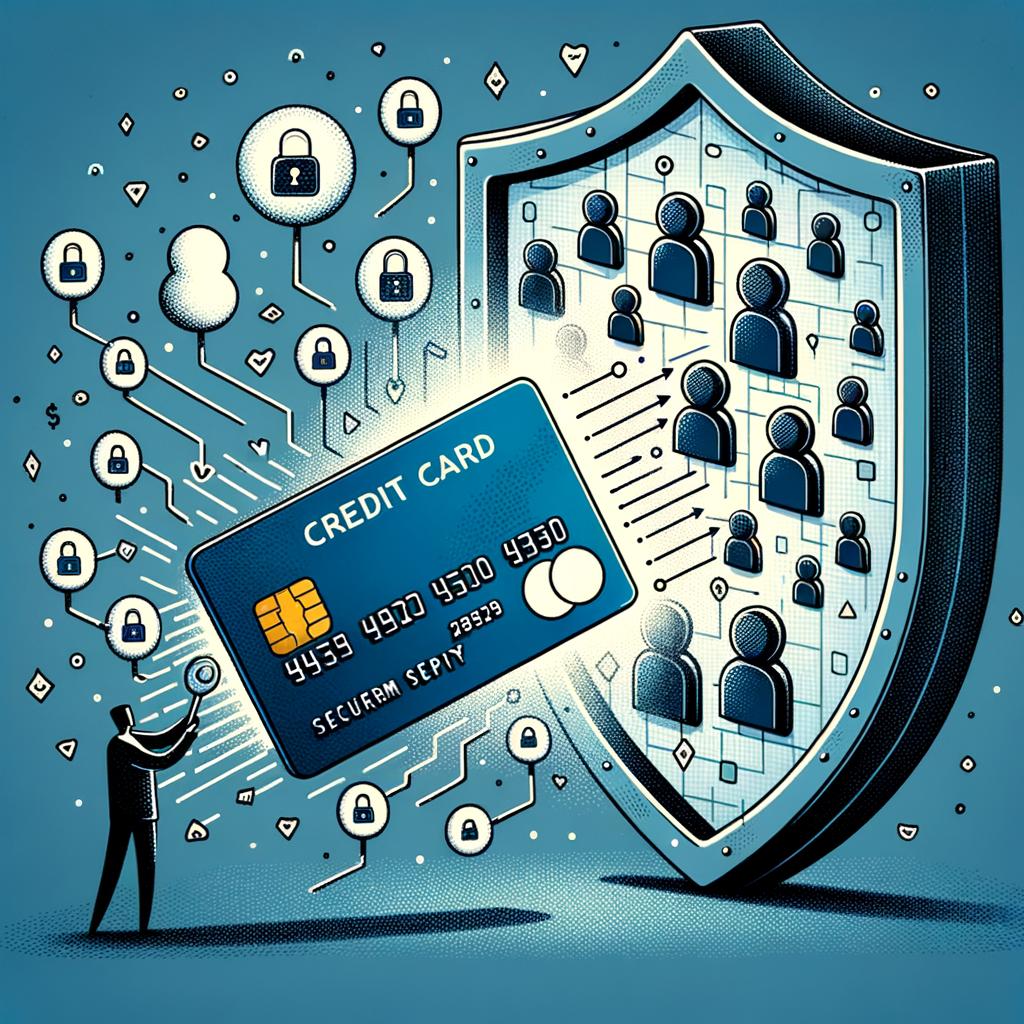Encryption and Tokenization in Protecting Cardholder Data
Calling all cardholders and security enthusiasts! 🚨 Are you tired of constantly worrying about the safety of your precious cardholder data? Well, fret no more! We bring to you the ultimate secret weapons in the world of cybersecurity: Encryption and Tokenization. 🛡️💳
In this electrifying article, we will dive into the marvelous realm where strings of data transform into impenetrable fortresses, where hackers cower in fear, and where your card information is as secure as a well-guarded treasure trove. We’ll traverse the intricate pathways of encryption and tokenization, unraveling their mysterious powers to protect your hard-earned money from the clutches of cyber villains.
Imagine your card data shrouded with an invisible cloak that renders it utterly indecipherable to any unauthorized eye. That’s precisely what encryption does! Just like a cryptic puzzle, it transforms your sensitive digits into an enigmatic jumble, making it virtually impossible for sneaky adversaries to extract any meaningful information. It’s like speaking in the language of spies, rendering the data useless to anyone who doesn’t possess the secret decoder ring.
But wait, there’s more! Brace yourselves for the staggering might of tokenization! This technologically advanced sorcery replaces your real card details with a mystical substitute, aptly named a token. It’s like entering a masquerade ball, where your true identity is hidden behind an elegant mask. Tokens are used for transactions, leaving zero room for hackers to feast on your actual card information. It’s as secure as walking through a shifting maze where the real card data is trapped, while the token dances safely away from prying eyes.
Join us on this thrilling expedition into the protective world of encryption and tokenization, where words like “breach” and “compromise” become relics of the past, and your precious cardholder data is guarded like the crown jewels. Get ready to unlock the secrets of cyber defense and emerge victorious against the relentless foes of digital thieves. Let’s reclaim our peace of mind, one encrypted step at a time!
Encryption and Tokenization: Safeguarding Cardholder Data in the Digital Era
In today’s digital era, ensuring the security of cardholder data is of paramount importance. Encryption and tokenization have emerged as powerful techniques to safeguard sensitive information and protect it from unauthorized access and fraudulent activities.
Encryption serves as a robust shield for cardholder data by converting information into an unreadable format. This process ensures that even if an attacker gains access to the data, they will not be able to understand or manipulate it without the proper decryption key. With encryption, all valuable cardholder information, such as credit card numbers and personal details, are scrambled into a complex code, making it virtually impossible for cybercriminals to decipher.
Tokenization, on the other hand, takes data security to the next level by replacing sensitive cardholder information with unique tokens. These tokens act as substitutes, allowing organizations to securely process transactions without storing the actual card details. By implementing tokenization, businesses can significantly reduce the risk of data breach and mitigate the impact of potential attacks. Moreover, in the event of a breach, the stolen tokens would be worthless and ineffective without the corresponding back-end encryption system.
To summarize, encryption and tokenization together provide a robust defense against threats in the digital landscape. By leveraging these techniques, businesses can protect cardholder data, gain customer trust, and safeguard sensitive information from falling into the wrong hands. It is crucial for organizations to implement these security measures as part of their overall cybersecurity strategy to combat the ever-evolving challenges posed by cybercriminals.
Securing Cardholder Data: The Power of Encryption
When it comes to safeguarding cardholder data, encryption and tokenization take center stage as crucial methods to ensure the highest level of protection. These powerful techniques offer robust security measures that thwart unauthorized access and minimize the risk of data breaches.
Encryption: Utilizing complex algorithms, encryption converts sensitive cardholder data into an unreadable format, rendering it useless to anyone who tries to intercept it. By encrypting the data both during transit and while at rest, businesses can effectively shield cardholder information, making it virtually impossible for cybercriminals to decipher or misuse.
- Securely transmitted data: Encryption ensures that data transferred between devices, networks, or systems remains encrypted, safeguarding it from unauthorized interception.
- Protected stored data: Encrypting data when stored in databases or on physical devices adds an additional layer of security, making it extremely challenging for hackers to access and misuse.
- Key management: Proper encryption also requires robust key management, ensuring that encryption keys are securely stored and managed to maintain the integrity of the encryption process.
Tokenization: Complementing encryption, tokenization offers an added layer of defense by substituting cardholder data with random tokens that bear no relationship to the original information. This technique replaces the actual data with unique identifiers, keeping the sensitive information out of reach of malicious actors.
- Data protection: Through tokenization, sensitive cardholder data is never stored within an organization’s systems, reducing the risk of exposure and potential repercussions in the event of a breach.
- Streamlined transactions: Tokenization enables quick and seamless transactions by using the tokens for processing, eliminating the need for repeated data entry.
- Compliance: Employing tokenization assists businesses in complying with industry regulations and standards, ensuring that sensitive information is well-protected.
Tokenization: An Effective Solution for Cardholder Data Protection
Tokenization is a robust and reliable solution for protecting sensitive cardholder data. By replacing the original data with a unique identifier called a token, the risk of exposing valuable information is significantly reduced. With tokenization, even if a data breach occurs, the stolen tokens are rendered useless as they don’t contain any meaningful information. This process provides an added layer of security for both businesses and their customers, ensuring peace of mind for everyone involved.
One of the major advantages of tokenization is its ease of implementation. With just a few simple steps, businesses can integrate tokenization into their existing payment systems. By working directly with a trusted tokenization service provider, sensitive data can be encrypted and replaced with tokens, which are securely stored in a separate location. This ensures that even in the event of a breach, the original cardholder data remains safe and secure.
Another benefit of tokenization is its versatility. Tokens can be used across multiple platforms and systems, making it a seamless solution for businesses operating in various industries. Whether it’s e-commerce websites, mobile applications, or in-store Point-of-Sale systems, tokens can be effortlessly utilized to process transactions while maintaining the highest level of security. Additionally, tokenization helps to simplify compliance with industry regulations such as the Payment Card Industry Data Security Standard (PCI DSS).
In summary, tokenization is a highly effective solution for cardholder data protection. Its implementation is straightforward, and the use of tokens ensures that sensitive information cannot be compromised. This method not only enhances security but also streamlines transactions across different platforms. By adopting tokenization, businesses can demonstrate their commitment to safeguarding their customers’ data and maintaining their trust.
Best Practices for Encryption and Tokenization Implementation
When it comes to protecting cardholder data, encryption and tokenization are two powerful tools that every organization must consider. By encrypting sensitive information and replacing it with unique tokens, businesses can ensure that even if a breach occurs, the data remains useless to attackers.
- Choose strong encryption algorithms: Selecting robust encryption algorithms ensures the security of your data. AES (Advanced Encryption Standard) with 256-bit keys is currently considered one of the most secure encryption methods.
- Implement end-to-end encryption: It’s crucial to encrypt sensitive data not only in storage but also during transmission. Ensure that all communication channels, including website forms and APIs, use SSL/TLS encryption to protect against interception.
- Secure key management: Safeguarding encryption keys is vital to maintaining the integrity of your data. Store keys in a hardware security module (HSM) or a secure key vault to prevent unauthorized access.
Tokenization complements encryption by replacing sensitive data with non-sensitive tokens that are useless to thieves. This technique is especially useful in environments where real cardholder data is not required.
- Centralize tokenization services: Consolidating tokenization in a central system reduces complexity and improves manageability. This allows for easier implementation and maintenance of tokenization processes.
- Choose tokenization vendors carefully: When selecting a tokenization provider, ensure they meet industry standards and have a strong reputation for security. Evaluate their tokenization algorithms and security measures before making any commitments.
- Audit and monitor tokenization processes: Regularly review tokenization activities to detect any anomalies or potential vulnerabilities. By monitoring token usage and access, you can quickly identify any suspicious behavior and take appropriate action.
| Encryption Algorithm | Strength |
|---|---|
| AES-256 | High |
| ChaCha20 | Medium |
| Twofish | Medium |
Wrapping Up
And voila! With encryption and tokenization, your cardholder data is magically transformed into a fortress of protection. It’s like having your own personal secret agent guarding your precious information from any prying eyes. So go ahead and swipe, tap, or insert that card with confidence, knowing that your data is locked up tighter than Fort Knox.
But we can’t stress this enough: encryption and tokenization are the superpowers you need to keep on your side. Don’t take them for granted. Stay updated with the latest encryption algorithms and tokenization methods because, let’s face it, the bad guys are getting smarter too.
So, next time you whip out your credit card, remember the invisible shield of encryption that wraps it, keeping your transactions safe and sound. And let’s raise a glass to technology that not only makes our lives easier but also shields us from the shadowy underworld of cybercrime.
Now that you’re armed with the knowledge of how encryption and tokenization work, spread the word. Share this information with your friends, family, and that nosy neighbor who always seems to peek over your shoulder at the checkout counter. Together, we’ll create a world where cardholder data is protected, and cybercriminals are left scratching their heads in frustration.
And if you’re still not convinced of the power of encryption and tokenization, well, you might as well hand your card over to those sneaky hackers, right? Just kidding! Stay vigilant, stay informed, and sleep easy knowing that your cardholder data is wrapped up in an impenetrable fortress of security.
So, keep on swiping, keep on tapping, and keep on shopping – all while frolicking in the digital wonderland of encryption and tokenization. Cheers to a world where cardholder data can roam free without fear, thanks to the superheroes of technology!






